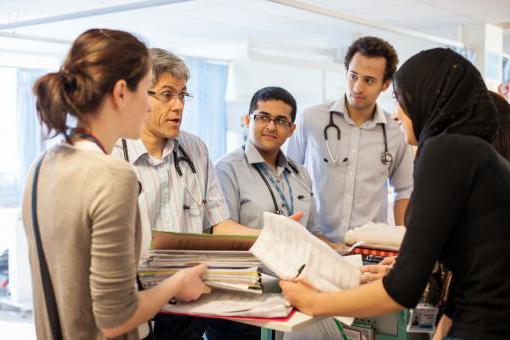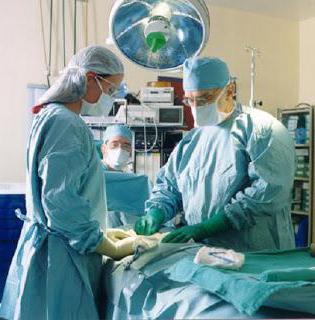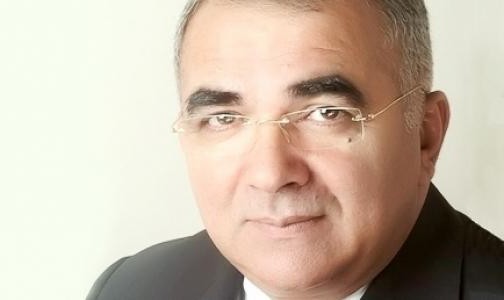The St. Petersburg Medical Academy of Postgraduate Education (SPbMAPO) has a long history.
It began on June 3, 1885 with the opening of the Clinical Institute , which in 1896 received the honorary title of the Imperial. The idea of creating this institution belonged to such famous figures of medicine of the 19th century as I.P. Pirogov, N.F. Zdekauer, E.E. Eichwald.
The need to create
The Imperial Clinical Institute, one of the activities of which was the postgraduate education of doctors, was opened thanks to the efforts of the Grand Duchesses Elena Pavlovna, as well as her daughter Ekaterina Mikhailovna. They were the highest patrons of the institute. With them, his building was built according to a project created by academician of architecture R.A. Gedike.
This institute was extremely important for the development of domestic medicine. Indeed, in the second half of the 19th century. only a few Russian doctors had the opportunity to improve their knowledge by visiting postgraduate departments of foreign universities. Moreover, the country urgently needed qualified personnel, especially Zemstvo doctors.
The participation of the Grand Duchess
In 1823, the youngest son of Emperor Paul I married Princess Württemberg Frederick Charlotte Maria (after the adoption of Orthodoxy, Elena Pavlovna). This was one of the most enlightened and educated women in Russia of that period. Emperor Nicholas I even called her a "scientist of the family." Elena Pavlovna constantly patronized famous figures of Russian culture and science.
She also provided charitable assistance to medical education institutions. Elena Pavlovna was distinguished by liberal views. She actively contributed to the implementation of peasant reform in Russia, after which the first released her serfs.
The idea of medical scientists regarding the creation of a special institute dedicated to the improvement of doctors was warmly supported by the Grand Duchess. And in 1871 Elena Pavlovna was transferred to the disposal of the necessary territory. This is a plot in the city center, the location of which was Kirochnaya street. Subsequently, the Clinical Institute opened on it. The princess donated 75 thousand rubles for the construction of this institution. Equally important for the institute and its further development was the support of other benefactors. They donated capital for the needs of construction, the purchase of equipment, as well as for the maintenance of free beds in the institution.
Activities of the Institute during the reign of the Romanovs
The Imperial Clinical Institute was visited by doctors who wanted to improve their knowledge on the basis of the latest scientific achievements. They signed up for paid as well as free courses, listened to lectures by famous professors.
At the beginning of its activities, the current St. Petersburg Medical Academy of Postgraduate Education had four departments:
- therapy, which was led by Eichwald E.E .;
- pathological anatomy with bacteriology (head - professor M.I. Afanasyev);
- Surgery (under the guidance of Professor Monastyrsky ND);
- pathological physiology (head - professor A.V. Lel).
Since 1894, the Clinical Institute became part of the Ministry of Education. His guardianship was carried out by the sons of the Princess-patroness Ekaterina Mikhailovna, who are also known for their many deeds of mercy and charity. These are the Dukes Georgy Georgievich and Mikhail Georgievich. The first of them was the trustee of the institution until 1909, and the second until 1917.
Thanks to donations, the Institute was able to continue and develop its activities. The advanced medical scientists who worked in it filled the knowledge gaps of practicing Zemstvo doctors, giving them the opportunity to get acquainted with the most advanced methods of getting rid of diseases at that time, which allowed even provincial doctors to keep up to the level of necessary scientific requirements and justify the hopes placed on them. Such prominent professors as Sklifosovsky N.V., D.O. Ott, Teeling G.F., A.K. Limberg, O.O. Mochutkovsky, N.A. Mikhailov, D.L. Romanovsky and many others.
During the reign of the Romanov family, several more departments were opened at the institute, namely:
- ocular;
- nervous;
- gynecological;
- ENT;
- syphilitic;
- urological.
By 1915, the institute's hospital served 211 beds.
After the outbreak of World War I, a hospital was opened at the institute, which later became MAPO St. Petersburg, and courses for the training of nurses were organized. In total, a large number of patients underwent treatment at the clinic before the revolution. Their number exceeded 23,000 people.
The coming of people's power
After the revolution, the Clinical Institute began to be funded by the state. Postgraduate education of doctors has become mandatory in it. Since 1924, the name of this institution has changed. It was renamed the State Institute for the improvement of doctors, or GIDUV. As before, many prominent medical figures of the country worked in it. Among them: Academician N.N. Perov, Professor R.R. Harmful, J.L. Lovtsky, R.V. Kiparsky, G.D. Belonovsky. In the period from 1920 to 1930, the staff of the Institute’s doctors was replenished by many academicians and professors who were the pride of Soviet medicine. Among them: V.A. Oppel and Z.G. Frenkel, V.L. Polenov and E.S. London, P.G. Korlev and A.A. Limberg, O.N. Podvysotskaya and many others.

The prestige of GIDUV did not fall in the postwar period. Such famous scientists as L.A. worked at the institute. Orbeli and M.F. Glazunov, N.I. Blinov and V.S. Ilyin, V.L. Vanevsky and G.V. Golovin, O.K. Khmelnitsky and S.A. Gadzhiev, A.V. Vorontsov and A.G. Earthy, as well as many others.
In the Soviet period, the success of GIDUV was marked by various high state awards. So, on the eve of its fiftieth anniversary, the institute was awarded the Honorary Order of Lenin. He was given the name S.M. Kirov. By the centenary of the institute received the Order of the October Revolution.
In 1985, the world saw the book, which describes the history of the Clinical Institute. In honor of the centenary of the institution, the opening of the museum. All this recognized the merits of people, thanks to the efforts of which for the first time not only in our country, but throughout the world, a special system began to function, working to improve doctors.
Temple
Back in 1860, almost 2 years after the construction of the building of the Imperial Clinical Institute, architect R.A. Gedika was presented a project on the construction of the church. This was instructed by Princess Elena Petrovna.
The temple of the academy began to be built after the finishing work in the main building was completely completed. By 1.09.1883, a dome was erected, a head with a cross was installed and the ceiling and walls were painted. Further, the commission that directed the construction of the institute sent a petition to Metropolitan Isidore of St. Petersburg and Novgorod with a request for the opening of the church. The issue was resolved by the Holy Synod on 10.27.1884. The church was named after the holy Equal-to-the-Apostles Queen Empress Helena in honor of Princess Patroness Helena Pavlovna.
The church was painted by the famous decorator S.I. Sadikov. By September 1883, a two-tier iconostasis was installed in the church. It was designed by R.A. Gedike, and completed the workshop of I. Schroeder. By the first of November 1884, an image was placed on the iconostasis. They were written by the artist N.D. Kuznetsov.
Back in July 1884, six copper bells were installed in the belfry. In January of the following year, an altarpiece appeared.
Some objects of the temple were executed in modeling and marble. The masters V.D. Repin and G. Botto.
The consecration of the church took place after the grand opening of the Clinical Institute. However, further work on the arrangement of the temple did not end. The functioning of the church continued until 1919, when on March 25 it was closed, and four years later it was liquidated. In the early thirties, the dome was demolished from the building and the fundamental library of the institute was placed in it. This continued until March 1998, when the administration of the academy decided to restore the church. All necessary work was completed by mid-spring of 1999. At the same time, icons were made. To write them invited the artist E.I. Fill up. She performed the image of the Savior on the throne and Our Lady of Hodegetria, Saints Constantine and Helena, as well as the archangels Gabriel and Michael. Her hand belongs to the icons of the Exaltation of the Cross and the Honest Life-Giving Cross. Artists N.A. worked on the royal gates with the image of the Annunciation of the Blessed Virgin Mary. and N.G. Bogdanovs.
All the work done is performed on the chords using the egg tempera technique. Kohler was prepared only from natural pigments, similar to those used in ancient times by ancient Russian recorders. These are azurite and cinnabar, ocher and lapis lazuli, glauconite and vivianite, as well as many others. According to traditional Russian technologies, gilding of assis (patterned dressing) was performed. In conclusion, all the icons were covered with drying oil. This gave the paints extra brightness and prevented the work from the negative effects of the environment.
The consecration of the temple took place on June 3, 1999. Archpriest Prokofiev Alexander Alexandrovich was appointed its rector.
The house temple of the Academy, which provides advanced training for doctors, was the only one existing in medical institutions of the city and revived in its historical place. Today it hosts Divine Liturgies, weddings, baptisms, prayers, funeral services and funeral services.
Rename
In 1992, GIDUV, in accordance with the newly adopted law "On Education", passed the first certification in its history. And since 1993, according to the Government Decree of April 16, 1993 No. 662-r, it was transformed into the Academy, received the name "St. Petersburg Medical Academy of Postgraduate Education". Then the institution adopted its new Charter. In 1994, the St. Petersburg Medical Academy of Postgraduate Education received its first license from the Russian State Committee for Higher Education. According to this document, the Academy was assigned the right to carry out work aimed at improving the qualifications of doctors in postgraduate, as well as additional education.

The expansion of the work of SPbMAPO resulted in the opening of a large number of new departments. By 1995, there were already 84 of them, and ten years later - 87. At the academy, doctors from St. Petersburg and other regions of Russia periodically improved their qualifications. For the year, the number of students in the institution was about 26 thousand people.
Conversion
Since 2011, MAPO SPb ceased its independent existence. In order to improve medical education, the Ministry of Health decided to merge the two oldest universities in the country. November 12, 2011, the North-West State Medical University named after I.I. Mechnikov. It included two institutions. This is the St. Petersburg Medical Academy of Postgraduate Education and the St. Petersburg Medical Academy. I.I. Mechnikov.
According to the statutory documents, Northwestern State Medical University named after I.I. Mechnikov has a founder represented by the Ministry of Health of the Russian Federation. Legal address: St. Petersburg, Kirochnaya street, house 41.
What are the benefits of the conversion? The newly created state medical university has great potential. Today, the institution is able to closely coordinate and interact with clinical, educational, and research work. All this allows the graduation of highly qualified competent specialists who not only possess modern knowledge, but also successfully apply them in practice, as well as provide high-quality post-graduate education for doctors.
Rector
To date, SZGMU them. Mechnikov is led by Otari Givievich Khurtsilava. The future professor, doctor of medical sciences, was born on 06/23/1950 in the city of Tbilisi. His career began in 1967. Then Otari Givievich Hurtsilava got a job as an ambulance in his hometown at an ambulance station. In 1969, he entered the Leningrad Sanitary and Hygienic Medical Institute, which he successfully graduated in 1975. Then there was the work of an internal surgeon in the Leningrad Hospital for the treatment of invalids of the Great Patriotic War. From 1976, Otari Givievich was a doctor at the Leningrad Ambulance Station, and from 1983 to 1995, he was an endoscopist at the Kirovsky Zavod Medical Unit No. 7. In 1981, he went to work in the Department of Outpatient Therapy and Diagnosis of Tumors of the Scientific Research Institute named after I.I. Petrova. Here he became a clinical intern.

In 1995, the rector of SPbMAPO S. Simbirtsev left his post And right up to the merger of the Academy with the University. I.I. Mechnikova O.G. Khurtsilava was here the vice-rector for clinical work.
In 1998, he successfully defended his candidate dissertation, and in 2008 - his doctoral dissertation. In the period from 1999 to 2007, O.G. Khurtsilava was the head of the Pokrovskaya hospital, which is one of the most famous healthcare institutions in St. Petersburg.
Otari Givievich is the author and co-author of a large number of articles published in medical journals. In 2000, he chaired the scientific-organizational committee of the first Russian-American symposium addressing interventional cardiology issues. In 2009, he was a member of the Presidium of the Scientific Committee organized for the 4th Interdisciplinary Conference on Perinatology, Obstetrics and Neonatology.
Otari Givievich Khurtsilava was awarded a medal in honor of the 300th anniversary of St. Petersburg. He also has the Order of St. Daniel of the Moscow Russian Orthodox Church.
The work of the University. I.I. Mechnikov
To date, almost 4300 students are getting higher education at this educational institution. Moreover, 3,000 of them are accepted on a budgetary form of training, and 1,200 pay for the knowledge they receive. In addition to Russian citizens, there are students from different countries at the university.
Thanks to an extensive medical and research base, the institution trains 650 interns, as well as more than 1100 clinical residents. 460 graduate students, doctoral students and applicants for academic degrees are conducting dissertation research at the university. Here, doctors of St. Petersburg and other regions of Russia improve their professional qualifications. Each year their number is about 30,000 people.
At the North-Western State Medical University named after Mechnikov carried out and diagnostic activities. It is carried out in 25 different medical profiles, using 800 beds located in six clinical facilities owned by the institution. Every year, doctors SZGMU them. Mechnikov provides highly qualified care to 40,000 inpatients and 300,000 outpatients.
As for the research work, then within the walls of the university it is carried out in full accordance with the most relevant areas of life sciences. At the same time, special attention is paid to research carried out in the field of sanitary-epidemiological direction and public health.
In the long term, the university focuses on the effective use of the results of applied and fundamental scientific activities in building a favorable educational environment that provides a continuous process of training highly qualified personnel.
Main goals
What is the main mission of the North-Western State Medical University named after I.I. Mechnikov, which included the St. Petersburg Medical Academy of Postgraduate Education? What are the goals of the institution? According to the administration and the entire teaching staff, they are as follows:
- in the training of highly qualified specialists who received a medical education in Russia, who are able to successfully work in the 21st century;
- in carrying out innovative scientific activities and introducing their results into practical education and healthcare;
- in the implementation of highly effective medical assistance to citizens of the country;
- in the formation of spirituality and high morality of the Russian doctor.